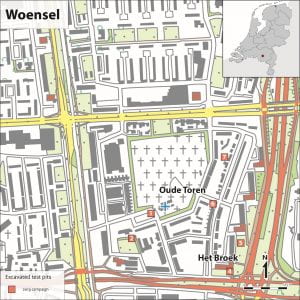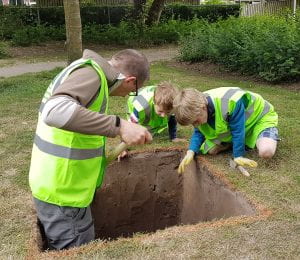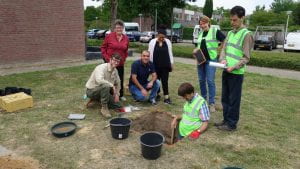
Six test pits were excavated in Woensel in May 2019, in the Oude Toren area and the northern part of Het Broek. The excavations were carried out by 32 volunteers organised by the local archaeology club ‘Archeologische Vereniging Kempen en Peelland’.
Despite the extensive recent development, pre-modern archaeological layers proved to be surprisingly well-preserved. The earliest finds date to the (Roman) Iron Age, with pottery from this period found in several pits, indicatiave of settlement on the coversand ridge in late prehistory. However, no definite evidence of Roman pottery was found.

Finds from test pit 1 (near the Old Tower) confirm the presence of habitation at this location in the late eighth to late ninth century AD. A sherd of Merovingian pottery hints at a pre-eighth century origin for settlement here, but interestingly this sherd was not found next to the church but closer to the river in test pit No. 6. In this same pit part of a feature believed to be a well was discovered underneath the man-made plaggen soil (a soil layer artificially fertilized with a mixture of manure, turf, litter and sand), cut into the natural substrate. The absence of the anthropogenic plaggen soil in the fill of the well indicates that it dates back to at least the mid-eleventh to mid-thirteenth century. The location of this well, along the causeway north of Broek, could indicate that this hamlet initially extended further towards the river.
 Test pit 4 (in Het Broek area) revealed a clear sequence of occupation and demolition of a succession of houses up until the present-day flat was constructed, suggesting the pit was or close to one of the historic farmhouses. Finds include a porcelain figurine and the bowl of a clay pipe moulded in the shape of the Roman god Saturn.
Test pit 4 (in Het Broek area) revealed a clear sequence of occupation and demolition of a succession of houses up until the present-day flat was constructed, suggesting the pit was or close to one of the historic farmhouses. Finds include a porcelain figurine and the bowl of a clay pipe moulded in the shape of the Roman god Saturn.  Analysis of the finds to date showed habitation on this site to date back to at least the sixteenth century, but natural was not reached and the pit will be completed next year.
Analysis of the finds to date showed habitation on this site to date back to at least the sixteenth century, but natural was not reached and the pit will be completed next year.
